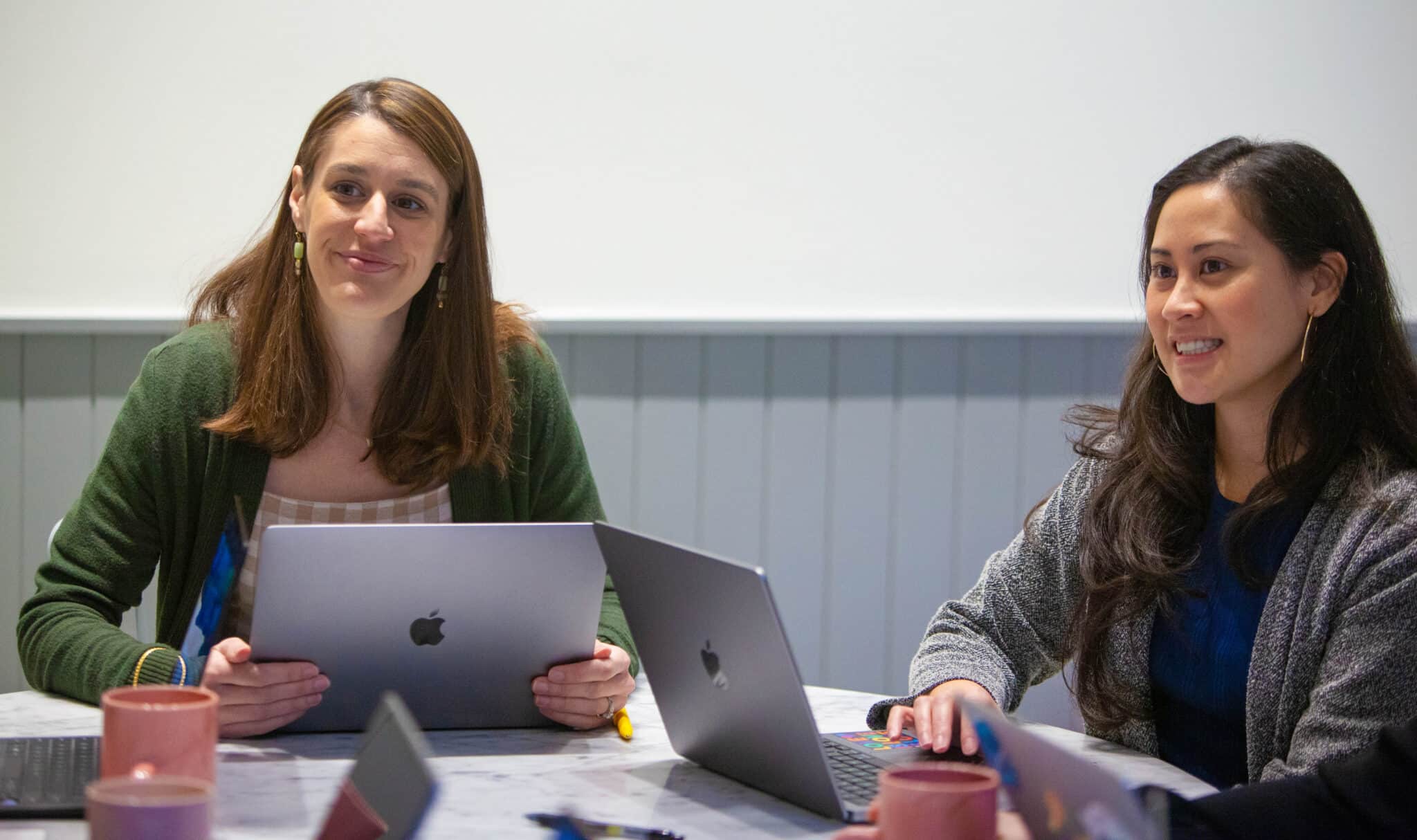The following is a transcript of our podcast conversation with Mikaela Kiner, Michelle Fink, and Kim Freeman. You can listen to the full episode on Spotify or Apple Podcasts.
Sarah Wilkins
Welcome back. In today’s episode, we are talking about creating a culture of caring and a human friendly workplace. As a working parent and one experiencing caregiving on a daily basis, this topic is very personal and one I feel can be addressed is some tactical steps that will help with retention and burnout. As a caregiver, I want to do my best work and be a present parent for my daughter. I used to believe this wasn’t all possible at once or was left feeling burnout trying. Finding a human friendly workplace in Reverb showed me it was possible by making some small but important changes. Keep listening if you want to make your workplace more human friendly but aren’t sure where to start.
Sarah Wilkins
First, I want to start by defining what human friendly means. I shared my personal experience of needing a family friendly workplace. But to be human friendly, we look beyond those in caregiver roles which span everything from childcare to elder care to how we can set up a work environment that works no matter what is happening in the employee’s life.
Sarah Wilkins
An important foundation to have a human friendly workplace is to create a culture of caring. According to the Caring Company study, in the absence of supportive care culture, employees worry that admitting to caregiving responsibilities penalizes their career growth. This creates an environment where employees might be struggling with performance, productivity and wellness, but you as an employer won’t know and can’t adequately support them. This likely includes not just caregiving employees, but other employees that have things going on in their lives as well.
Sarah Wilkins
We all want to create a workplace that is inclusive and allows people to do their best work in a way that works for them. There are a few tactical things you can implement to create a more inclusive environment for your employees, which include flexible working hours, which is a simple change and can have a great impact on your team. Providing flexibility on when someone signs on to work or is available allows those with other responsibilities to do things like pick up children from school or take elder parents to a doctor’s appointment without fear of being seen as not available or not productive. To help make this successful, ensure you create an asynchronous work environment that allows people to stay informed and pick up work without needing to meet or leave someone out.
Sarah Wilkins
Second, look at your leave policies and make sure they are inclusive. The US. Does not offer family leave, caregiver leave or bereavement leave at a national level. While some states are implementing their own state level programs, there’s still a large gap to fill. As an employer, you can set up leave policies that are inclusive. For example, have a new parent leave policy that’s inclusive of anyone in a caregiving role associated with a new birth or adoption, not just a birthing parent. Or you can implement a bereavement policy that is more broadly defined as all immediate relationships versus immediate family. You can also include pregnancy loss and miscarriage in your bereavement policies to support employees going through difficult fertility journeys.
Sarah Wilkins
I interviewed a couple Reverb team members to hear how they’ve helped Reverb or other clients create a human friendly workplace.
Sarah Wilkins
First up, I’m talking with Michelle Fink, Reverb’s Director of Operations, on how she set up Reverb with a more asynchronous work environment to support our flexible working schedules. Our team at Reverb is spread across time zones and provides a flexible work environment, so having these mechanisms in place was important.
Sarah Wilkins
Michelle, what did you do at Reverb and what other recommendations do you have for companies in similar situations?
Michelle Fink
I have a few key things that we’ve done that I believe have the highest impact for the team. And the first thing is ensuring we have the right tools in place. We started with a free CRM HubSpot and Google, which has all the collaborative tools you might need to start out. And as we prepared for growth and as we were financially able, we’ve added on more tools that enable that remote work and work that is collaborative. So things like Slack for quick messaging and less email. We use Panda Doc, which is our contract software that integrates with our CRM and my current obsession Notion, which started as a project management tool, but we use it for so much more now and whatever the tools may be that meet your business needs. Having these tools that serve as a vehicle for virtual collaboration, it’s reduced meetings for us and it can eliminate some meetings altogether so everyone can jump in during their working hours and contribute. So everything keeps moving along and we’re no longer waiting on the next meeting to continue progressing and we’re not waiting on someone to send an email update. The first thing, the tools you’re using is something you want to take a look at.
Sarah Wilkins
I love that you shared that because just yesterday we had an example where we were able to eliminate a meeting because of our tool like Notion that we’re using to keep track of status and updates and things like that. So anyone can go in anytime and get the information they need. And I’m sure everybody is excited to get the hour back on their day too.
Michelle Fink
Yeah, I love hearing that. And the next thing I focus on is documentation. And sometimes it can be documentation of the way you’re using the tools together, but mainly documenting processes or policies to ensure you’re working in a time zone agnostic way. And we make documentation accessible to anyone who might need it. And we give access and visibility to as much information as possible, and within reason of course, taking into account any confidentiality concerns. But this allows individuals to self serve and if everyone knows to be using the tools in the same way, it can be very effective. Documentation is an ongoing responsibility though maintaining these takes time, but it’s so important and it empowers employees, it supports their autonomy and it supports the business and continuity of the business. So I’m constantly working on updating documentation of our processes and making more and more resources available. One thing I wanted to share that we’ve always done and improved upon year over year is documenting our internal rhythm of business. And I believe it’s critical to creating an asynchronous workplace where we don’t rely on any one individual to remember these recurring items that they own or that others own that need to be taken care of to keep the trains running, so to speak. It’s all documented and calendar and this year I’m working on segmenting this into business groups to make it more digestible for teams and they might not need to see the big picture all at once and they can see their organizational unit or just the things that they own and they’ll be able to do that.
Sarah Wilkins
That’s great. I really like not having a single point of failure. That’s always one of my biggest concerns. So having that set up and documented is amazing.
Michelle Fink
Exactly. The last thing that ties all of this together nicely in a bow is fostering a culture of communication. I love and appreciate over communication. I model it regularly as well as encourage it, and so do other leaders on the team. So naturally it has become part of our culture. And if we’re keeping everyone in the loop who just might play a part in an initiative or a project or a decision, then we’re ensuring that information is constantly flowing so that everyone can do the work they need to do. And in some cases, they’ll chime in to mitigate any potential issues or downsides. Thanks to that proactive FYI that someone gave. And by over communicating, we’re also getting input from team members that we might not otherwise have received. And individuals have all this information instead of bits and pieces to make those decisions or form their opinions, those decisions are more well thought out and ultimately help the company grow in a positive direction.
Sarah Wilkins
I like pointing this out because this really increases diversity of opinions and as we know, diversity of opinions can strengthen teams and lead to better results. So implementing something like this can really improve your business.
Michelle Fink
Yeah. And the last thing, Sarah, that I want to share before leaving is just that we’re all working with people, so we want to be respected and included. And I have a quick list of things that you can start doing right now. And one is normalizing scheduling slack messages or emails within your coworkers time zone. It’s the respectful thing to do and we can start doing that today. The next is when setting meeting times or informal virtual gatherings, depending on the time differences you have across your team. Set a time that overlaps for everyone or rotate the times of some kind of recurring meeting to make those meetings more convenient for all time zones. Then the next is if you have something that doesn’t have confidential information in it, then share it and take the time to spend time as just people. Working virtually can start to be more transactional if you don’t make an intentional effort to build relationships with others. And we need to continue to build those relationships, to build trust. So just take the time to hold those virtual water coolers, have some fun check ins on Slack, do a virtual holiday toast, and if you’re able, do some in person events.
Sarah Wilkins
Thank you so much, Michelle. This advice is really helpful and practical, and I know it’s something people can take away and implement today. So thank you again.
Michelle Fink
Thanks for having me. Sarah, I’m super passionate about setting up processes that enable our team, and I just really hope this helps others.
Sarah Wilkins
Next, I chatted with Kim Freeman, a reverb senior people operations consultant, on how she supported clients in creating inclusive lead policies. Welcome, Kim.
Kim Freeman
Thank you so much, Sarah. Happy to be here.
Sarah Wilkins
Kim, what are some best practices you’d share in creating inclusive lead policies in your experience?
Kim Freeman
Sure. So I think the overarching encompassing theme should be that this policy should nurture flexibility and trust among the employees. Right. When organizations are considering leave policies that they consider all of their workers, all of the different family types and cultures and things that are important to different groups of people, organizations should be generous but realistic and trying to encompass all of the lead plans within a policy. Bottom line is organizations have to consider financial considerations when they’re implementing these programs. So absolutely be generous, but also take into consideration the budget that you have when you’re implementing these policies. And in terms of having an inclusive policy, consider having that one policy that includes personal time, sick time, vacation time, compassionate leave, parental like all of those things. Consider those when you’re factoring in all the components that go along with the leave program. Consider those things so that you nurture that spirit of trusting your employees to do the right things. In terms of requesting time off. Because in times past, in years past, a lot of times when organizations had separate leave plans, like, for example, sick leave versus vacation, when you have just a bucket of time, rather than saying, oh, I have sick time, so I’m just going to call in and I’m going to take sick time, even though I’m really not sick. So when organizations consider PTO or having that one bucket of time, it encourages employees to use their time. And with post COVID and all of the things that went along with COVID and employees getting burned out and all of those things having that one bucket of time and having leaders who are supportive of having the one bucket of time. Also encouraging their employees to take time away from work so that they can decompress and they can recharge and be ready when that lead time is over.
Sarah Wilkins
Pointed out so many good things and I love how just workers in different stages of their lives or what families look like and then the trust is huge.
Kim Freeman
Absolutely.
Sarah Wilkins
I was talking to someone recently about bereavement leave and just not requiring your employees to tell you who they lost and trusting that they’re using the time because they need it. I think I really love that you pointed out just having trust in your employees.
Kim Freeman
Absolutely. That is a factor that oftentimes gets missed when employers are creating these plans and oftentimes they go into it as though we don’t want to spend X amount of dollars because we know employees are going to abuse it. Like, you don’t want to go into it with that mindset. You want to go into it that the mission that the organization is on is important to the people who are working for them and that they’re going to use their time wisely for whatever reason they choose to use it.
Sarah Wilkins
Absolutely. Thank you. What is something that companies often miss when setting up these leave policies?
Kim Freeman
Sure. So one thing in particular regarding parental leaves is to have that gender-neutral policy as opposed to having paternity leave and maternity leave. Let’s just call it parental leave because oftentimes when you set it up with paternity versus maternity, oftentimes you miss a big segment of the population, those employees who are adopting. And so you want to make sure that you have the language. Yes, it’s gender-neutral when you say parental. However, it is also inclusive of all family types. So that’s one piece and then one huge piece of the parental policies that are missed is compassionate leave. So if a family has a pregnancy that does not result in having a baby and just giving families, employees the opportunity to process through that grief, that’s a piece that I’ve seen in a number of policies that have been missed or even adoptive families where the adoption falls through last minute, just providing that extra time for them to process through that.
Sarah Wilkins
Thank you for pointing that out. And that’s absolutely something I think that is missed. But it’s still something so important for people to be able to take the time away and process that loss.
Kim Freeman
Absolutely. And then even in conjunction with that, when families are transitioning back into work, employees are transitioning back. Whether it was a birth or whether it was an adoption, whatever that addition of child, however it came to be, oftentimes we provide the bonding time to families, but when it’s time to transition back into work, it’s like, okay, leave us over. And there’s no gradual or graduated return. And I’ve seen one organization in particular who offers graduated return to work for the families. And I think that has been a huge win for this particular organization because the employee, whether it’s a male employee or a female employee or they/them employee, they appreciate the fact that they don’t have to just one day say, okay, I’ve got to leave my baby and I have to go back into work. As opposed to an organization allowing them up to a certain number of PTO hours to still transition back into work. Because maybe there’s a concern with child care. The child care is only available 20 hours for a certain period of time and that sort of thing, or even just leaving the baby in a daycare setting and the family is not ready for that. And so maybe they’re ready for 10 hours a week or 20 hours, but just being able to not have to be forced into returning right away and starting a child in daycare and all of those things. So that’s another piece that graduated returned to work for parents
Sarah Wilkins
yeah. That brought me back to six years ago when I was returning to work after my leave and just having that time, it’s a hard time, right, to come back and to go full force back into work. And so being able to come in part time or work out a schedule to get yourself up back to that time, if that’s where you want to be.
Kim Freeman
Absolutely.
Sarah Wilkins
Thank you. Kim, any other final thoughts you’d like to leave us with?
Kim Freeman
I think the only thing I would say is how I started, so how I started the messaging. Let’s nurture flexibility and trust. Let’s do that. Let’s consider all workers, whether it’s temporary, part time, full time, whatever that is, all worker categories and all family types. And then also, let’s be generous, but also let’s be financially responsible for fiscally responsible and be realistic based on our budget.
Sarah Wilkins
Great. Thank you so much, Kim. This is really great insight. I know many companies can take these things and put them into place at their company, so thank you.
Kim Freeman
Absolutely. You’re very welcome.
Sarah Wilkins
Finally I talked to Reverb CEO Mikaela Kiner on how to create a culture of caring and spread that throughout the organization. Welcome, Mikaela, good to have you.
Mikaela Kiner
Yeah, absolutely.
Sarah Wilkins
Mikaela. Reverb has a culture of caring. How have you incorporated that into the culture?
Mikaela Kiner
Yeah, I love this question because we spend so much time together at work and so I just think how we treat one another is so important. The first thing I think is really it is just emphasizing that and for us, we’ve made kindness one of our values. And so I think actually having something in the values itself that speaks to how people treat one another and what that expectation is, is really important. Also looking for that when we interview and when we hire to make sure that it is a priority for everyone that we bring onto the team, just like it is for us here in the organization. And then I think just even really small actions make a difference. And so recognizing people, thanking people, making sure that there is a safe space for people to share if something difficult is going on for them, either at work or personally. And just making sure that we’re really here to acknowledge that and give people the time and space and support that they need to just kind of deal with everyday struggles and challenges.
Sarah Wilkins
That’s great. Thank you. And I think all those things really point to creating kind of a psychologically safe work space and having that culture of caring leads to safety at work.
Mikaela Kiner
Yeah, it really does. And I think it’s interesting, I can’t remember when psychological safety, when that exact term was coined. And so I think there are things that are important and have been important and then that framework really crystallizes it and helps have almost more intention or more of a methodology. But you’re absolutely right, just creating that safety, as you said, is really key. And then I think of the opposite of who would want to work anywhere that did not have psychological safety or why. Right. Why would we make that choice, assuming that we have a choice to make.
Sarah Wilkins
Yeah, and then my last question is, do you have any advice for leaders on how they can create a culture of caring and ensure it spreads throughout the levels of the organization? You mentioned a couple of things previously, but anything else you would share there?
Mikaela Kiner
Yeah, I think that the biggest thing when it comes to leadership is really role modeling, that idea of walking the talk. And I think this is hard for some leaders though, because we might be good at demonstrating or expressing care for others, but this is where also taking care of yourself is really important. And so showing people that you do take vacation or maybe it’s that you’re not on email weekends and evenings, or when you’re sick, you’re not coming to work. Right. And so some leaders push themselves really hard. And I think it’s easy to forget that people are listening not only to what you say, people are really watching your behaviors, and it does give them permission to do the same. So just a quick story, but I did kind of my own 360 feedback a few years ago now, and it was really interesting because in the comments, there was more than one of people encouraging me. Like, I do take vacation and I do spend family time, but it was like, take more. We want to see you take even more vacation or we want to see you take even more time with your family. And I thought that was so great because sometimes as a leader, it’s so common to ask, am I doing enough? Like, am I working hard enough? Am I setting that tone? But it was just a great reminder that kind of setting that opposite tone is equally important. And people really need to see you doing that in order to feel like it’s okay to do that themselves.
Sarah Wilkins
Yeah, and I think you model that so well, and it’s allowed me to do the same things, like the nights and weekends and taking the time off without feeling guilty. I think you’ve been a great model of that behavior, reverb so thank you.
Mikaela Kiner
Yeah, thank you. I mean, it’s kind of funny to go like, well, what’s your superpower? Well it’s going on vacation? Which is really I mean, if you’re going to do one thing, it’s a really fun thing to be able to do. And I love that it’s meaningful to people. Like, I never thought of it that way, I guess, until I heard that from the team. So how’s happy to role model some work life balance.
Sarah Wilkins
That’s great. Thank you so much. And thanks again for your insights on those questions. All right, my pleasure.
Sarah Wilkins
There were so many great takeaways from my conversations with Michelle, Kim, and Mikaela, but to summarize, some key words or things that I took away were really about flexibility, trust, communication and respect. By incorporating these things and designing with that in mind, you can have a human friendly workplace as well. Thanks for listening.
To listen to more episodes of Humans Beyond Resources, click here.














